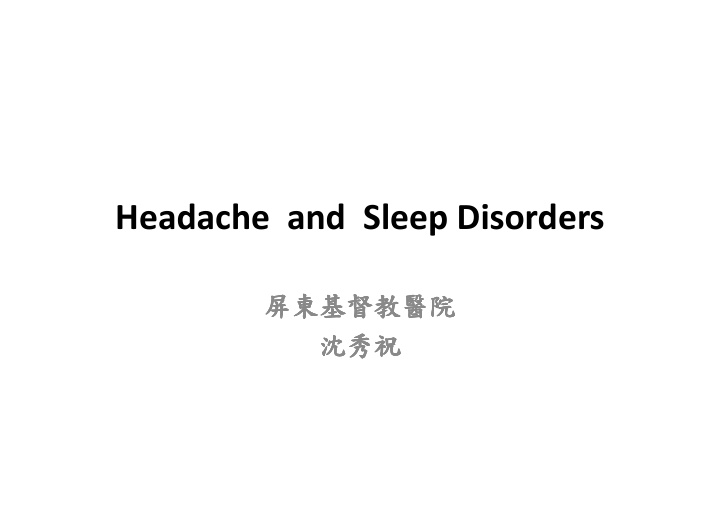



Headache and Sleep Disorders 屏東基督教 屏東基督教醫院 屏東基督教 屏東基督教 醫院 醫院 醫院 沈秀祝 沈秀祝 沈秀祝 沈秀祝
Sleeping later � Sleep deprivation � Excessive Sleep � Sleep � Migraine Sleep Headache Physiology of sleep Clinical, Anatomical, and Physiologic Relationship Between Sleep and Headache Headache 2003;43:282-292
Paiva T, etThe relationship between headaches and sleep disturbances. Headache. 1995;35:590-596.
Potential relation Classification Sleep and Headache Sleep Medicine Reviews, Vol. 6, No. 6, pp 471–479, 2002
Clinical, Anatomical, and Physiologic Relationship Between Sleep and Headache Headache 2003;43:282-292
Most frequent differential Diagnosis to sleep related headaches Sleep and Headache Sleep Medicine Reviews, Vol. 6, No. 6, pp 471–479, 2002
Primary Headache Disorder related to Sleep Migraine Cluster Headache Chronic Paroxysmal Hemicrania Hypnic Headache
Anatomy And Physiology Of Sleep
The Hypothetical Anatomical Basis REM sleep “on” cells lateral nucleus reticularis pontis oralis (ventral to the locus ceruleus in the pontine tegmentum) REM sleep “off” cells noradrenergic locus ceruleus serotonergic dorsal raphe nucleus serotonergic dorsal raphe nucleus NREM sleep the medullary nucleus of the solitary tract nucleus reticularis of the thalamus anterior hypothalamus basal forebrain
Neurotransmitters and Sleep • Acetylcholine � � � � activation in wakefulness and in REM sleep • Norepinephrine � inhibit REM sleep Norepinephrine � inhibit REM sleep • Dopamine, histamine, GABA , adenosine, opioid, other neuropeptides � unclear role
Circadian Physiology of Sleep • Principal biological clock is located in the suprachiasmatic nuclei (SCN) of the hypothalamus. • Human biological pacemaker has an intrinsic periodicity of 24.9 hours • Photic entrainment is mediated by two pathways: • Photic entrainment is mediated by two pathways: 1. direct retinal projection to the SCN 2. indirect pathway from the lateral geniculate nucleus • Endogenous melatonin is probably the strongest biological marker of the circadian rhythm in humans.
Clinical Association of Sleep and Headache Sleep and Headache
Migraine .— • • Occurring during nocturnal sleep, after brief periods of diurnal sleep, and awakening • A peak occurrence in the early morning • Periods of REM sleep and with morning • Periods of REM sleep and with morning arousals (stage III, stage IV) • Autonomic activity and serotonin change in both REM sleep and during a migraine attack.
Migraine • 30% to 55% Somnambulism • Outside attack � normal sleep , slight � REM quantity and latency • 60% elation, irritability, depression, hunger, 60% elation, irritability, depression, hunger, thirst, or drowsiness preceding 24 hours thirst, or drowsiness preceding 24 hours suggestive of hypothalamic origin • A disturbance of the cerebral circuits concerned with adaptive homeostatic mechanisms
Cluster Headache • Occur about 90 minutes after the person falls asleep • Coincides with the onset of the first REM sleep( during stages II and IV ) sleep( during stages II and IV ) • Serotonergic transmission in the central nervous system, alters circadian rhythm
Hypnic Headache • Frequent occurring every night or more than 4 nights per week • The principal biological clock is located in the SCN of the hypothalamus SCN of the hypothalamus • Subsequent reduction in melatonin
Treatment of sleep disorders • Sleep disorders most implicated with headache - obstructive sleep apnea - primary insomnia - circadian phase abnormalities. - circadian phase abnormalities. • Treatment of obstructive sleep apnea can improve headache -polysomnography -method: weight loss, treatment of nasal allergies, upper airway surgery, and CPAP
Sleep regulation • Behavioral sleep therapy includes: (1) Schedule consistent bedtime that allows 8 hours time in bed; (2) Eliminate TV, reading, music in bed (3) Use visualization technique to shorten time to sleep onset (4) Move supper >4 hours before bedtime (5) Discontinue naps
Summary • Medical conditions (e.g. obstructive sleep apnea, depression) that may disrupt sleep and lead to nocturnal or morning headache • Primary headache disorders which often occur during nocturnal sleep, can readily be diagnosed during nocturnal sleep, can readily be diagnosed through clinical evaluation • Patients with poorly defined nocturnal or awakening headaches should undergo polysomnography to exclude a treatable sleep disturbance
Insomnia Sleep Apnea Hypersomnias Sleep Fragmentation Migraine Tension headache Cluster Headache Physiology of sleep Hypnic Headache Chronic Paroxysmal Hemicrania Clinical, Anatomical, and Physiologic Relationship Between Sleep and Headache Headache 2003;43:282-292
Recommend
More recommend